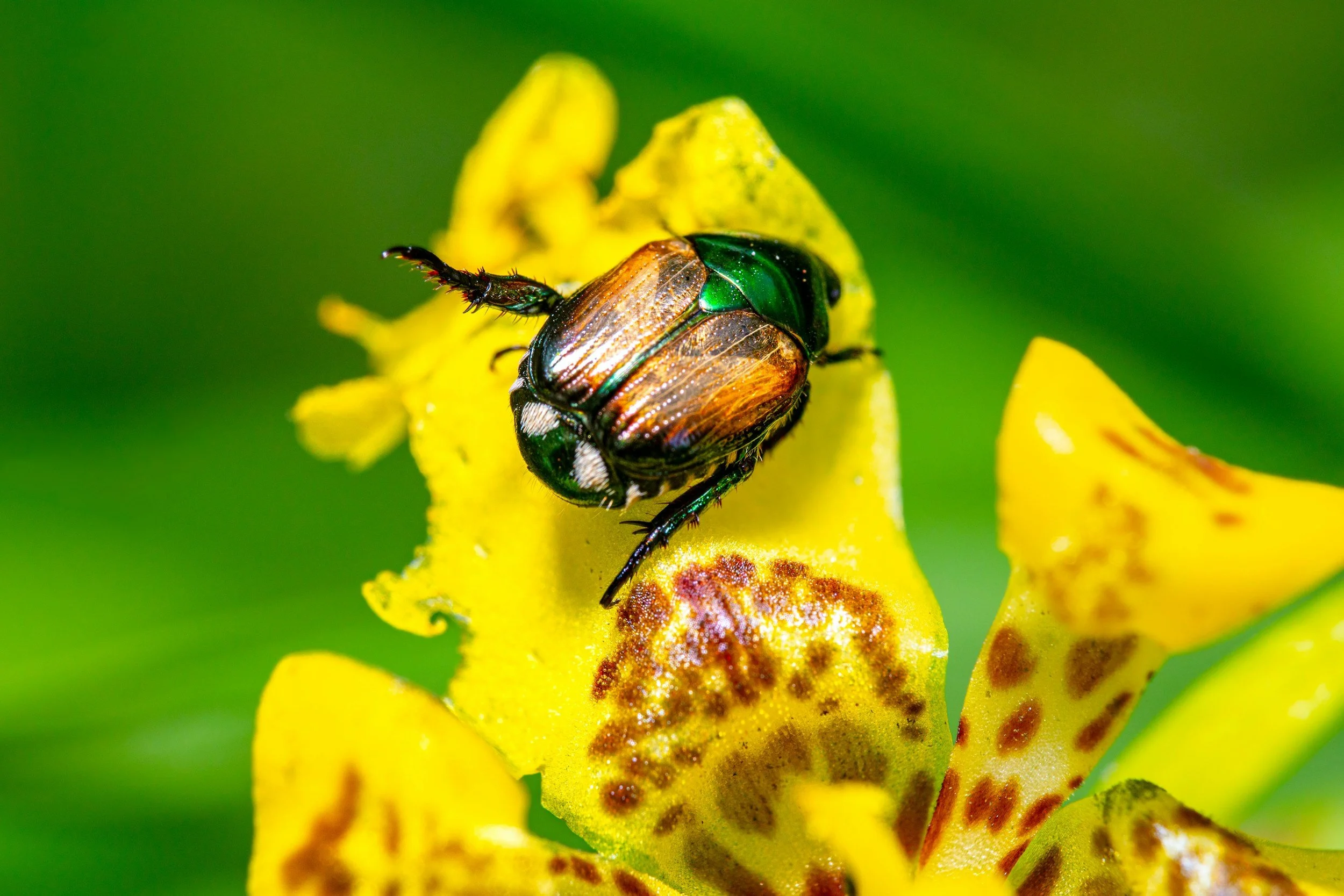Japanese Beetles: History + Silver Lining
Popillia japonica, aka Japanese beetles, are a species of scarab beetle native to Japan. They are known for their distinctive metallic green bodies and copper-colored wing covers. They are about 1/2 inch long and have small white tufts of hair along their sides. Japanese beetles are highly destructive to many plants, including roses, grapes, linden trees, and many types of fruit and vegetable crops. Adults feed on the foliage, flowers, and fruits of over 300 plant species, while larvae (grubs) feed on the roots of grasses, damaging lawns and turf.
These beetles were first discovered in the United States in 1916, in a nursery near Riverton, New Jersey. It is believed they were introduced unintentionally through imported ornamental plants from Japan. In Japan, natural predators and environmental factors keep their population in check, but in the U.S., they faced no such constraints, leading to rapid population growth and spread. Since their introduction, Japanese beetles have spread across much of the eastern United States and parts of the Midwest. They are currently found in most states east of the Mississippi River and are slowly moving westward.
When life gives beetles…
The challenge to control the Japanese beetles in our gardens presents a unique opportunity to get kids involved in nature. By engaging children in hands-on activities such as hand-picking beetles, inspecting plants for damage, and encouraging beneficial predators, they can learn valuable lessons about ecology, responsibility, and the importance of sustainable gardening practices. This involvement not only helps manage the beetle population but also fosters a deeper connection with the natural world, encouraging a new generation of environmentally conscious individuals.
Hand Picking/Shaking it All About: Controlling Japanese beetles can be challenging due to their wide host range and mobility. To manage Japanese beetles with kids, start with hand-picking activities where kids collect beetles by hand and place them in a bucket of soapy water. This teaches them about the beetle life cycle and the importance of controlling their population.
Another engaging method is the shake and catch activity, conducted in the morning when beetles are less active. By shaking plants to dislodge the beetles onto a sheet or tarp, kids can learn how beetles are more sluggish in the morning, making them easier to catch.
Inspecting Plants: In garden activities, encourage kids to regularly inspect plants for beetle damage. This teaches them to recognize signs of beetle damage and understand its impact on plant health. Setting traps at a distance from the garden can also be an effective activity, allowing kids to learn how traps work and discussing the pros and cons of using them.
In the Garden: Encouraging beneficial insects like ladybugs or parasitic wasps into the garden is another excellent activity. This helps kids understand the role of natural predators in the ecosystem and their importance in controlling pest populations.
To attract these helpful insects, start by planting a diverse array of flowering plants that bloom at different times of the year, providing a continuous source of nectar and pollen. Plants such as dill, fennel, coriander, marigolds, cosmos, and yarrow are particularly attractive to ladybugs and parasitic wasps.
Providing shelter is also essential. Create habitats by leaving small patches of the garden undisturbed with leaf litter, mulch, or rocks where beneficial insects can hide and breed. Additionally, consider building or buying insect hotels to offer dedicated shelter and nesting sites for these helpful bugs.
Avoiding the use of chemical pesticides is crucial as they can harm beneficial insects. Instead, opt for natural pest control methods and organic gardening practices to maintain a healthy insect population.
Providing water sources is another simple yet effective strategy. Place shallow dishes of water with a few stones or twigs in your garden, giving insects a place to land and drink, especially during dry periods.
Using compost and organic mulch can enrich the soil, attract beneficial insects, and improve overall garden health. Mulch also provides a habitat for ground-dwelling beneficial insects, creating a more inviting environment for these natural pest controllers.
Keeping a Log: Creative and fun projects like creating a beetle diary can help kids track beetle sightings, control methods used, and results. This activity helps them understand the effectiveness of different methods.
Make Some Friends: Forming a small gardening club or team to tackle beetle control together can foster a range of positive outcomes beyond just pest management. Working collaboratively in a group setting encourages teamwork, as members share tasks and coordinate strategies to effectively address beetle infestations. This collective effort not only divides the workload but also combines diverse skills and ideas, leading to more innovative and comprehensive solutions.
In addition, involving others in beetle control initiatives also instills a sense of responsibility, as each member takes ownership of specific tasks or aspects of the garden’s care. This shared responsibility helps individuals feel more engaged and committed to the success of the project, reinforcing their dedication to maintaining a healthy and vibrant garden.
Remember:
Always supervise young children during these activities to ensure safety.
Teach kids to wash their hands thoroughly after handling beetles or garden materials.

